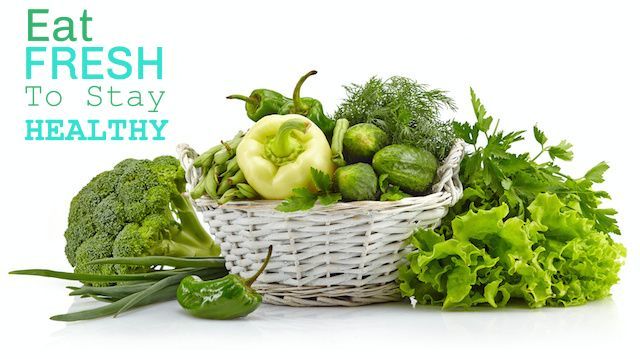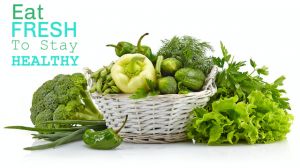
One of the sad victims of globalization has been the end of eating seasonally. Most people stroll through the supermarket picking up oranges in December and strawberries in February, not giving it a second thought.At some point in time, you might have had the fortunate experience of eating fresh produce picked straight from the plant. A tomato for example, warmed by the sun until it has the brightest shade of red and the most delicious sweet flavor. This is the magic of seasonal eating. Tomatoes from the supermarket just don’t taste the same, do they? They have been picked too early and gotten half-mushy with only a meager reddish hue by the time they arrive off the truck.
Savvy health-conscious people are now getting on the seasonal eating train, and for good reason. It’s not only better for your taste buds — there are many benefits for your health, the environment, and the local economy too.
When you choose to buy vegetables that were recently picked, you’re supporting the efforts of local farming families, many of which grow on a smaller scale and use less damaging chemicals.
You also get to enjoy produce that is much fresher and has not lost its nutritional value during a long trip from who knows where. Research shows that produce from your local area supports more robust health and immunity.
Another benefit of eating seasonally is saving money. When there’s plenty of something around, it tends to sell for cheap. So now that we’re entirely convinced to try eating seasonally, what are the best places to find good local produce?
How to find quality produce in your area
Probably the easiest way to get your hands on the bounty of the season is to walk through a local farmers’ market. You will know that the zucchini is fresh off the vine and the blueberries have been sun-ripened on the bush. Shopping at the market also gives you a chance to ask the seller about the way that the plants have been grown, if you would like to stick with organic produce. This is a unique personal experience that brings you closer to the food you eat.
The next step is, of course, to grow your own food! Even the smallest home can accommodate a few pots on the balcony, or by a sunny window, to grow some herbs or a few tomatoes.
If you’re simply shopping at the supermarket, be sure to bring along a list of what’s in season. It’s difficult to judge by price alone, since many bulk-priced items might be shipped in from another country where they are in season (even if it isn’t locally). Take the time to get to know what is grown and harvested in your local area.
Websites such as SustainableTable.org, FarmMatch.com and EatWild.com are handy resources to hook up with local farms, community groups and co-operatives with access to seasonal produce.
What vegetables are in season in the summer?
Summer is one of the most bountiful times of the year, and the best season to go out and buy lots of fresh veggies from your local suppliers. The summer produce offering is packed with so many wonderful colors, flavors and textures to enjoy.
Vegetables in season now:
- Radishes—These bright and spicy little root vegetables are best in late spring to early summer. Nutritionally, they are a good source of vitamin C, folate and potassium. Heirloom varieties of different colors are becoming more popular, to compliment the typical red and white radish we are all used to. Look for radishes with few blemishes and without mushy spots. The skin should be smooth and the attached green tops should be fresh-looking rather than wilted.
- Arugula—This peppery plant has become very popular in recent years, as the typical salad has migrated away from iceberg lettuce to more colorful and nutritious varieties. Munch on arugula for a good dose of beta-carotene and a cancer-fighting flavonoid by the name of kaempferol. When shopping for arugula, organic is definitely best. Stick with bright green leaves that look lively and crisp, with no yellowing.
- Cucumber—Cucumber is a good source of vitamin A, silica and magnesium, amongst a variety of other nutrients. Despite the high water content, cucumber is highly nutritious and worth eating. Select a firm and heavy cucumber with shiny skin of a deep green color.
- Green Onions—This humble vegetable has one of the highest antioxidant and cancer-fighting ratings. Snipping it with scissors is the easiest way to add it on top of practically any dish for added flavor. Be sure to pick stalks with good green coloring and no slime or floppy ends.
- Beets—Peak season for beets is mid-summer through to late fall. Be sure to avoid sugar beets since these are often GMO. Stick with locally grown heirloom varieties, including the striking candy-cane beet. The deep-colored root is so visually appealing thanks to the pigments called betalains, which are also antioxidant. And don’t throw out the leaves, since they are a rich source of a laundry list of nutrients including fiber, vitamins A, C and K, calcium, iron and magnesium.
- Green Beans—Be sure to stick with organic green beans, since they are on the dirty dozen list for pesticide sprays. If you can find a good source, you’re in luck, since green beans stay in season through to early fall. Be sure to choose crisp and snappy beans with no blemishes.
- Bell Peppers—If you live in a warm and sunny climate, you will have access to incredibly sweet and vibrant local bell peppers. Rich in vitamins A and C, peppers of any color are sure to add incredible flavor and crunch to your summer dishes. Be sure to choose specimens with shiny, firm skin and no pits or wrinkling.
- Carrots—Did you know that carrots were originally yellow and purple? The orange variety we are all used to was only cultivated in the seventeenth century. You’ll have access to sweet, delicious carrots from midsummer to early fall. They store well through the winter, so you can keep a stash for a source of vitamins A, K and E throughout the colder season. The best carrots are firm and have feathery, lively green tops.
- Chard—Also known as silverbeet, chard comes with a variety of lovely colored stems. This part of the plant is a little more fibrous, but it can add a nice crunch to stir fries. Otherwise, the leaves can be used interchangeably with spinach or any other leafy green. Chard is not farmed on a huge scale and is a favorite of smaller farmers, so you should be able to find lots of good organic local options through farm shares or natural markets. Like most leafy greens, chard is best eaten cooked, since it contains an anti-nutrient called oxalic acid.
- Zucchini—Summer brings us a good selection of squash, including zucchini, crookneck, straightneck and pattypan. The warm weather versions tend to be more tender and thinner-skinned, while winter squashes such as butternut and acorn are hardier. Choosing organic is best, since the skin is usually consumed. This also guarantees the avoidance of GMO zucchini, which is unfortunately insidious. Since zucchini has a high water content, it does not store well, so eating freshly-picked local product is the best option. Try this vitamin B and potassium-rich veggie fresh in salads, or baked into muffins with dark chocolate chips.
- Lettuce—Tender leaves of lettuce can be grown just about anywhere, barring very hot climates. There are many lovely heirloom varieties to try growing in the garden. Be sure to stick with organic when shopping for lettuce, since it rates high on the dirty dozen list. Your investment will pay off in a healthy dose of fiber, vitamin A, vitamin C, calcium, folate and iron. Look for crisp, bright-colored leaves with no sliminess.
- Rhubarb—Originally hailing from Siberia, rhubarb is now known as a summer staple. It makes a great match with strawberries, citrus fruits and fresh creamy cheese. Choose the more red-colored stalks which are sweeter than those that are green.
- Spinach—This champion of greens enjoys cooler weather, so late or early summer are the best times to seek it out. Beware of pesticide-heavy conventional spinach, and visit the farmers’ market for lovingly cultivated heirloom varieties instead. Your body will enjoy an amazing offering of vitamins, minerals and nutrients that destroy inflammation and nourish healthy skin.
 With all of these bright colorful vegetables containing such a range of health-supporting nutrients just waiting to be snapped up, what’s not to love?
With all of these bright colorful vegetables containing such a range of health-supporting nutrients just waiting to be snapped up, what’s not to love?
In case you go a little crazy, since your dollar goes further when you’re buying locally, you should consider what to do if you’ve ended up with too many overflowing baskets of seasonal bounty. Rather than risking all that good food going to waste, take it upon yourself to learn some simple traditional ways to preserve fresh food for later consumption.
We challenge you to support your local community, your wallet and your health by shopping locally and in season. Once you try it, you’ll probably never go back to eating sad, chemically-ripened, trucked-in vegetables ever again!
-The Alternative Daily
Sources:
http://www.motherearthnews.com/real-food/seasonal-eating-zmaz07aszgoe.aspx
http://www.sustainabletable.org/seasonalfoodguide
http://www.naturalnews.com/035575_seasonal_food_diet_health.html
http://www.fruitsandveggiesmorematters.org/whats-in-season-summer
http://www.pbs.org/food/fresh-tastes/whats-in-season-during-the-summer
http://www.thekitchn.com/the-seasonal-produce-i-put-in-my-freezer-love-your-freezer-216217
http://www.marthastewart.com/276955/seasonal-produce-recipe-guide
http://www.gracelinks.org/blog/2158/real-food-right-now-and-how-to-cook-it-arugula
http://www.whfoods.com/genpage.php?tname=foodspice&dbid=42

